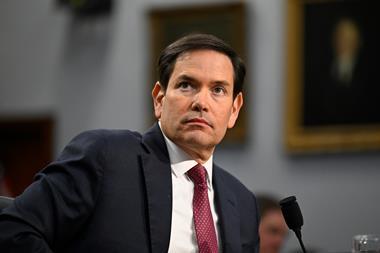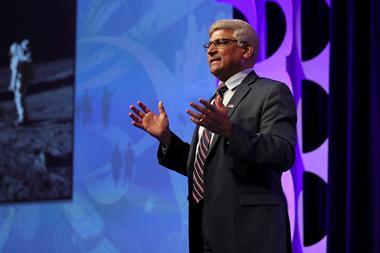The Trump administration has released more details of its budget request for the 2026 financial year and the picture for research is even worse than the ‘skinny’ budget released last month.
Funding for chemistry from the National Science Foundation (NSF) in the maths and physical sciences programme is projected to plummet by 75%, from more than $244 million (£180 million) last year to just over $61 million. Materials research would be cut by 71% to $92 million. And maths and physical science overall face cuts of 67% to $515 million.
The NSF – which supports fundamental research and education in non-medical fields of science and engineering – has calculated that its grant funding success rate will fall from an average of 26% to just 7% in the 2026 financial year – starting on 1 October 2025 – if the proposal is implemented. Overall, it is estimated that the agency’s budget would face a cut of almost 57% from over $9 billion to about $4 billion.
The number of NSF research grant applications is also expected to drop from 36,700 in 2024 to 33,000 in 2026, and the number of funded research proposals is expected to decrease more than 75% from 9600 to 2300.
‘If enacted, the FY26 budget request would end America’s global scientific leadership. The cuts to science would imperil our nation’s future health, security and prosperity,’ stated Sudip Parikh, the chief executive of the American Association for the Advancement of Science, who served as science adviser to the Republican leadership of the Senate Appropriations Committee and was responsible for negotiating the budgets of several science agencies. He said this budget proposal ‘stands in stark contrast to the president’s call for a renewed commitment to US scientific leadership’, and noted that Congress has demonstrated a bipartisan commitment to investment in research and should do so again.
‘The end of science in the US’
Neal Lane, a physicist who served as science adviser to former president Bill Clinton and previously as director of the NSF, recoiled when he read the details of the Trump budget proposal. ‘Having been at the helm of the NSF, I can only imagine how painful it is for people in the agency to actually produce the numbers for such a ridiculous budget,’ he tells Chemistry World.
‘If this budget request is enacted by Congress, then the impact would be catastrophic and irreversible,’ Lane continues. ‘But I don’t expect Congress to go along with this budget, yet it is an unusual time and predicting with any large confidence level would be folly.’ He anticipates that the final 2026 budget will involve substantial cuts, but not at the level proposed by the Trump administration.
‘I feel that Congress will negotiate these cuts, and the bottom line could be quite different,’ Lane says. He suggests that one possible outcome from Congress is another continuing resolution that maintains current funding levels for the next fiscal year, and a second possibility is more selective cuts. ‘I do expect cuts to federal government science agencies and research programmes, just less than what Trump is proposing.’
If Congress does approve this proposal, Lane expresses concern that it could mean ‘the end of science in the US’ or at least take decades for the enterprise to recover. ‘A hit like that would be discouraging to scientists and young people in the US who want to be scientists and engineers so many would just leave, and the talent from countries like China and India and other parts of the world may no longer come to the US,’ he says.
‘Even though it is a one-year budget where things are cut by half or more, I think it would have an irreversible impact on the US research enterprise,’ Lane warns. ‘It is the president and the administration telling Congress and other countries that we don’t believe that science is important anymore.’
The proposed budget came up at the second annual State of the Science address by the US National Academy of Sciences’ president Marcia McNutt on 3 June in Washington DC. ‘The elephant in the room right now is whether the drastic reductions in research budgets and new research policies across the federal agencies will allow us to remain a research and development powerhouse,’ McNutt stated during her talk. ‘Even here at the National Academies, we’ve been badly impacted by budget cuts, grant cancellations, conforming to new policies.’
She said one of her biggest concerns is that the pending science budget reductions will lead to ‘little high-risk, high-reward research being funded’.
During a panel discussion following McNutt’s speech, Heather Wilson, president of the University of Texas at El Paso who represented New Mexico in Congress for 10 years, said there is ‘an inconsistency between the policy and the numbers, and now the Congress needs to step up and pursue the policy with sufficient budget to advance American science’.
John Holdren, an environmental and climate scientist who was science adviser to former president Barack Obama, is also alarmed. ‘If anything resembling the NSF FY2026 budget request is passed by Congress it will be a disaster for American science and for the country,’ he tells Chemistry World. Within the proposed 55% cut for the agency overall, the Office of International Science and Engineering would be cut by 80%, education by 75%, biological sciences by 72%, and the number of researchers, students and teachers supported by NSF programmes would fall from 330,000 in 2024 to 90,000, Holdren notes.
‘The severe cuts to the government’s non-defense science and technology spending that Trump proposed in every one of his budgets in his first term were largely rejected by the Congress every time,’ he adds. ‘It is terribly important that Congress rise to its responsibility to all Americans once again by rejecting such unconscionable cuts to the scientific foundations of this country’s well-being.’
Downloads
FY 2026 NSF Budget Request to Congress
PDF, Size 2.32 mb

















No comments yet